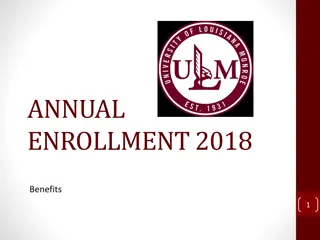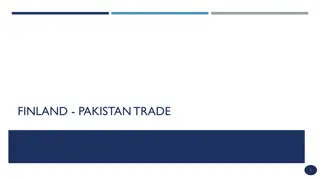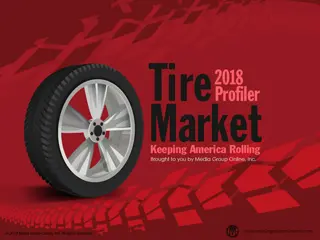Understanding Tablet Production Methods and Properties
Tablet production techniques such as direct compression and granulation are essential steps involving powder milling, mixing, and tabletting. The use of crystalline structures and disintegrants impact the compressibility and flowability of tablets. Not all materials are suitable for direct compression due to various factors. Good flowability, compressibility, and particle size uniformity are crucial for creating high-quality tablets.
Download Presentation

Please find below an Image/Link to download the presentation.
The content on the website is provided AS IS for your information and personal use only. It may not be sold, licensed, or shared on other websites without obtaining consent from the author. Download presentation by click this link. If you encounter any issues during the download, it is possible that the publisher has removed the file from their server.
E N D
Presentation Transcript
LAB.2 LAB.2 Tablet Production Methods Tablet Production Methods
Dry methods Direct compression Dry granulation Wet methods Wet granulation Regardless whether tablets are made by direct compression or granulation, the first step, milling and mixing, is the same; subsequent step differ.
Consists together property enable to compress directly with good flowability. of with compressing any the substances of substance physical It involves only two unit operations: Powder milling and mixing Tabletting. 1. 2.
4 12/14/2024
A crystalline structure, is more easily to compress than amorphous form because of the creation of certain cohesive bonds between crystals due to the pressure of compression, whereas in amorphous form it will not. Addition of a disintegrant to the formulation will helps to avoid the major problems in disintegration like (long time dissolution and melting).
Not all materials cant be easily or directly compressed: 1. Most materials having weak intermolecular attracting forces. 2. Materials are covered with a film of adsorbed gas that hinder compaction. 3. Large doses drugs don not lend themselves to this technique due to: Need of additives in a ratio of 1:1 for e.g. active constituent 500mg and diluent 500mg so will form (large tab., costly, difficult to swallow and not accepted by patients). 4. Small doses drugs can t be compressed directly like digoxin because there may be not sure to distribute uniformly. Direct compression used for moderate doses only (81-325)mg
Flowability Flowability Stable, inert, compatible Stable, inert, compatible Compressibility Compressibility Particle the Otherwise leading Particle size the particle Otherwise segregation leading to size should particle size segregation ( (demixing to lack should be size of of high the drug demixing) ) will of content be of of the high range, drug (be range, to (be close to meet close to will occur meet to it) occur it) lack of content uniformity uniformity Low cost Low cost Provide high pressure Provide high pressure- -hardness profile. hardness profile.
Low cost Low cost Few workers Few workers Elimination the thermolabile Elimination of the stability thermolabile and of heat but also and moisture heat and also the moisture sensitive and moisture, the suitability sensitive API s moisture, thus suitability of thus increasing of the API s. . increasing not the process not only process for only for stability but fewer processing steps fewer processing steps Space needed is low Space needed is low
There is little number of materials having crystalline forms. There is little number of materials having crystalline forms. The absorption Drugs directly The product absorption. . Drugs of directly. . product has has long long disintegration disintegration time time lead lead to to decrease decrease in in of low low dose dose like like digoxin digoxin ( (0 0. .25 25 mg) mg) can can not not be be compressed compressed Large doses can not be compressed directly. Large doses can not be compressed directly. Reactions amine (incompatibility) The and Reactions of amine resulting (incompatibility). . The process and result of excipients resulting in excipients with in yellowish with the the drug discoloration while drug like like reaction while the reaction of of spray the original spray dry original color dry lactose color is is brown lactose with brown with yellowish discoloration process is is carried result in carried out in mixing out in problems (hindrance in dry dry conditions, (hindrance of conditions, static of flowability) static charges flowability). . charges may may exist exist mixing problems Differences in particle size lead to segregation. Differences in particle size lead to segregation.
Aim of experiment : Preparation of aspirin tablets by direct compression Aim of experiment : Preformulation test: 1. a) (crystalline tubular or needle shape) b) Bitter or slightly acidic taste c) Odorless or have odor due to formation of acetic acid and S.A. in the presence of moisture. Preformulation test: 1. Organoleptic Organoleptic properties properties
Solubility Slightly soluble in water (1:300), highly soluble in organic solvent (1:5-7 alcohol, 2:10-17 ether, 1:17 chloroform). P.C. high (high solubility in lipids) and thus having good absorption in GIT wall so it is highly absorbed from stomach but also having good absorption from small intestine due to large surface area. Solubility 2. 2. Stability ( (unstable in so it dissolves in aq. Solution of carbonate and alkali hydroxyl with decomposition Stability unstable in water) due to decomposition (hydrolysis) 3. 3. water) due to decomposition (hydrolysis)
Preparations of aspirin Preparations of aspirin
1. Tablet a) Chewable tablet 100mg b) Swallow tablet enteric coated 100, 300, 325, 500 mg (irritant to the stomach due to the dissociation to form acid, so it is coated to prevent irritation to the stomach). c) Dispersible 75, 81 mg d) Bufferin 325 mg e) Effervescent tablet (Aspirin-C) (Librate or release ??2). f) Sustained release tablet 2.Injection(Aspegic 0.5gm, 900mg equivalent to 500mg of aspirin dissolve in 5cc water for inj.) D- Lysine and Glycine acetyl salisylic acid (dervative of aspirin) with improving solubility of aspirin by forming complex with lysine and glycine (inert aminoacids) 3.Powder for oral solution (Aspegic 100, 250,500 and 1000mg acetylsalisylate papers packaged in paper saschet) D- Lysine
Salt of aspirin (phenyl salicylate, sodium salicylate, methyl salicylate) toxic orally, used in topical ointment (high percutaneous absorption) so used in White field ointment (S.A., benzoic acid). Algesin (dimethylamine salicylate) Salicylamide, they have 1:500 water solubility but more stable than aspirin so widely used. Calcium acetyl salicylate used in prophylaxis in MI. 4. a) b) c) 5. Aspirin suppository 6. Aspirin in cold tablet phenylephrine, paracetamol) (promethasone, salicylamide, 7. Powders (for pharyngitis and tonsillitis locally used)
From the organoleptic properties of aspirin (crystalline and unstable in water) Wet method can not be used It can be prepared by dry method (dry granulation or direct compression) -for good crystalline and free flow materials like NaOH, NaBr, Benzoic acid-
Aspirin 75mg Starch 3mg Lactose Mg stearate 2mg (Active constituent) (Disintegrant) (Diluent) (Lubricant) 40mg
Mix all ingredients together after weighing (aspirin, disintegrant , diluent) for 15 minutes Then add the lubricant and mix for not more than 5 minutes Directly compress 1. 2. 3. Question : lubricant is added at last step . Why? Question : lubricant is added at last step . Why?























